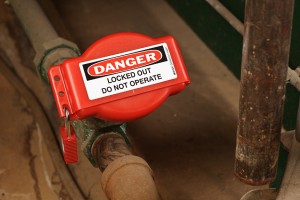Among the products that are overlooked when buying supplies for your facility, entrance mats are probably one of the most neglected. Far too many people consider entrance mats as decoration. Some think as long as it bears the customary welcome message, any generic variant is considered an adequate solution. This means that many people are failing to use these mats to their full advantage.
Archive for the ‘workplace-improvements’ Category
Top Four Reasons Why You Should Install Bollards

Bollards are often used in parks, worksites, along sidewalks, in front of establishments, and throughout parking lots. They provide an effective barrier to block both foot and vehicle traffic in outdoor environments. If you aren’t using steel bollards yet, it may be time to consider adding them to your workplace safety plan.
Here are the benefits of installing bollards in your outdoor spaces:
(more…)Keeping Warehouse Employees Motivated During COVID-19 & Beyond

By now, social distancing guidelines should be part of the daily operations in your warehouse. This “new normal” helps ensure your employees stay safe and healthy; however, some onsite workers may be feeling the impact of being separated from their colleagues and unable to work from home during this difficult time.
Luckily, warehouse managers and those in leadership positions can take a few small steps to make a big difference with their employees.
Encourage Open Communication & Be Accessible
The COVID-19 pandemic has emphasized the importance of everyone’s physical and mental health. Therefore, letting your employees know that you’re available to openly discuss the impact of the pandemic, how the workplace can be improved, or other feedback they have creates a healthier environment for everyone.
Take Time to Recognize Employee Efforts
While in-person conversations should be kept to a minimum, thanking employees for their continuous hard work is as easy as writing sincere emails or hosting virtual meetings. Showing gratitude can go a long way in terms of motivating and comforting employees now and in the future.
Continuously Provide Appropriate PPE
Onsite workers shouldn’t have to worry about having the personal protective equipment they need to do their job safely. Make a habit of providing new face masks, face shields, disposable gloves, and hand sanitizer to your employees. Not only does this show that you care about their safety, but it also helps stop the spread of germs in your facility.
Promote Motivational Messages
A positive work environment can lead to improved productivity and job satisfaction. Posting encouraging posters, signs, and floor markers throughout your warehouse will remind employees of the difference they make every day. Emedco offers a variety of motivating signs to display in your facility, including:

EM431 
EM432 
ML0045
EM431 — Your Effort is Recognized Floor Marker
EM432 — Our Business is Essential Floor Marker
ML0045 — Thank You Essential Employees Floor Sign
For more information on how to utilize our products, please view our Solutions for Essential Businesses Digital Catalog or browse our entire COVID-19 product offering.
GHS The Final Countdown: Common Misconceptions About Compliance
It’s been a long road to compliance; the updated Hazard Communication Standard (GHS) process officially started in 2009 and is set to wrap up this June 2016. A fully compliant GHS facility will bring with it improved quality and consistency of hazard information provided throughout the workplace, better comprehension for workers, quicker and more efficient access to SDS for workers, and a ton of money saved across industries.
With that being said some safety managers are still having trouble understanding a couple of areas of GHS that perhaps aren’t as cut and dry. Read on to get some clarity on these lingering misconceptions in GHS compliance.
Q: The containers within my facility vary in size and some of them are tiny, what is the minimum required information for small bottle GHS labeling?
A: There has been some debate on the minimum required information for small bottles. Initially, OSHA stated that labels must include all the required information. If the container is too small to print everything legibly on the label, then an extended content label would be necessary.
Added cost will not be an acceptable excuse for noncompliance.
There has been recent discussion that the following is the minimum you’re required to print on the small labels.
- Product identifier • Appropriate pictograms • Manufacturer’s name and phone number • Signal word • A statement indicating the full label information for the chemical
This might mean you can avoid the added cost of an extended content label.
Q: If there are 3 red squares on a label but I only need two pictograms can I keep the third one blank?
A: No. You either need to use a label template with the exact number of pictogram diamonds you’ll need or you’ll need to completely black out the unnecessary pictogram with black ink. If you’re printing your labels on-demand with a Brady Printer, this will not be an issue. Be advised that if a blank red frame is not fully covered and filled in, the label will not be in compliance.
Q: What is the major change between old HazCom Labeling and New GHS labeling?
A: The Old Hazcom standard was not universal and all business had their own system. Under the New GHS Standard all chemical manufacturers and importers are required to provide a universal GHS labels that includes a harmonized signal word, pictogram, and hazard statement for each hazard class and category. Precautionary statements must also be provided.
Q: Are any chemicals exempt from the GHS regulation?
A: No. GHS covers all hazardous chemicals. There are no complete exemptions from the scope of GHS for a particular type of chemical or product. The term “chemical” is used broadly to include substances, products, mixtures, preparations, or any other terms that may be used by existing systems. The goal of the GHS is to identify the intrinsic hazards of chemical substances and mixtures and to convey hazard information about these hazards.
For more information on the GHS regulations, click here.
Does OSHA Really Help Companies Get Compliant
There has always been a not so secret elephant in the room when it comes to businesses embracing OSHA regulations. Instead of welcoming OSHA and feeling like they have both company and worker best interests in mind, many see OSHA as the enemy; only worried about handing out fines and less about really helping to improve the safety of facilities.
OSHA was started with the goal of saving lives and compliance assistance in doing so for companies, where did this mission get lost in the minds of businesses along the way?
For businesses that are struggling to understand the complexity of a regulation given conflicting compliance resources, often times they feel like they are fighting a losing battle, with their only OSHA interaction being that of the bearer of bad news.
An ongoing senate subcommittee hearing titled “Examining Agency Discretion in Setting and Enforcing Regulatory Fines and Penalties” has set out to try and understand the perceptions of OSHA and how the focus can be shifted from writing fines (which inspectors are required by law to do if they find a violation) to a more ongoing compliance assistance approach.
OSHA does currently offer some compliance assistance services including: consultations, training courses, resources and partnerships.
If you feel like your facility could benefit from exploring these OSHA resources, click here for more information.
Tips on Developing the Best Safety Program for Your Facility
Many companies across the country have been recognized as “The Safest in America” over the years, for their dedication to making workplace safety a priority within their business. What’s the magic formula for success? It depends on the company, there is no single way to be the safest; however there are over arching themes that mostly all of the companies have in common.
Here are a few tips on how to develop the best safety program for your facility, as learned from the Safest Companies in America.
Go Beyond Compliance
While you are technically fulfilling your obligation by being compliant, sometimes that isn’t enough. Some OSHA regulations haven’t been updated for 20 or 30 years. Your workers lives could very well still be in danger. Go the extra mile and ask your workers if there are aspects of their jobs in which they feel that they are still over exposed to hazards and would like more protection.
Start from the Top
If your CEO doesn’t care about safety, neither will your managers or workers. A successful and sustainable workplace safety program only happens when it is enforces from the highest levels of a company. Set the tone from the top that procedures are important an must be followed because it is not only in the best interest of the workers but also the best interest of the company and its success.
Empower and Reward Employees for Making “Tough” Safety Decisions
It is not unheard of that workers are afraid to speak up or “waste” time with proper safety procedures out of fear that it will negatively impact production or a company’s bottom line. If a worker makes a call to “stop work” because a task is deemed too dangerous, don’t punish them for it, reward them! Make them aware that you support their decision and want to work towards a safer solution.
Make Comprehension a Priority
Not all workers are created equally, nor are the jobs they are hired to do. Some will need more time to grasp the safety principles that go along with their daily work tasks, or may need to learn by example. Be understanding of each of your workers’ individual needs in order to be their safest, most efficient workers. Allow them to shadow a more experienced worker, and continue to provide them the training and resources they need on a routine basis to keep them safe and maintain a clear understanding of the safety expectations within their position.
Track and Verify Effectiveness and Safety Performance
Implementing a program is not the tough part, sustaining it is. Once you have a good safety program in place, map out how you will maintain it. This should include input from all of your employees. Get managers and higher management involved to perform annual safety “town hall meetings” or surprise mock OSHA inspections to see how your program is doing and what ways it can be made better. A feeling of involvement goes a long way in a safety programs long term success or failure.
All Workers Have the Right to…
Losing your job is a scary thing to think about but losing your life should motivate you to speak up if you feel there is an issue within your workplace that has the potential to cause harm. Your job should not be at risk for reporting your observations, if you feel that it might be OSHA can help protect you.
The OSH Act was passed for this very reason back in 1970, to protect workers from being harmed. It is important that workers know their rights and do not turn a blind eye to risks.
According to OSHA all workers have the right to:
- Being trained in a language that they understand before commencing work
- Work on and around machines that are safe
- To be provided the proper safety gear to do their job
- To be protected from harmful chemicals
- Seek out and OSHA inspection and talk with the inspector
- Report their illness or injury and have copies of their medical documents
- Have access to workplace illness and injury reporting records
- Review records of work-related injuries and illnesses
- Obtain information from any tests done to find potential hazards in their workplace
If you feel that your workplace is not holding up their end of the bargain and management is unwilling to listen to you or your coworkers concerns, contact OSHA through filing a complaint to get the ball rolling.
Stand Down For What? Fall Prevention
You don’t know the true impact of gravity until it hits ya! In all seriousness, fall prevention and protection is a huge deal when it comes to working safely at heights. Falls from as little as 6ft can be fatal, heck falls while standing on the ground can be fatal. While the likelihood of serious injury while walking may not be high, the likelihood drastically increases as heights do. According to OSHA falls accounted for 40% of all deaths for the construction industry in 2014.
How can a difference be made? Participating in the National Safety Stand Down to prevent falls in construction is a good place to start. This event now in its third year has helped to raise awareness around preventing fall hazards, reaching over 2 million workers last year alone.
In addition to the event, OSHA shares tips on preventing falls from roofs, ladders, and scaffolding; three very familiar areas in which falls happen too often.
Falls from Roofs:
- Don’t forget your harness, and make sure it is worn properly and connected
- Always perform a fit test
- If guardrails or lifelines are part of your prevention program, Use them
- Inspect all fall protection to make sure that it is in proper working order
- Cover or properly mark all openings
Falls from Ladders:
- Choose the right ladder for the job
- Maintain three points of contact
- Secure the ladder
- Always face the ladder
- Guard or cover all holes, openings, and skylights
Falls from Scaffolding:
- Fully plank scaffolds giving workers a safely maneuverable working space
- Make scaffolding easily accessible
- Only build scaffolding on a level and secure foundation
- Assigned a knowledgably person to inspect all scaffolding before use
Key Lockout Tagout Definitions Every Safety Manager Should Know

The power of heavy duty machinery is largely left up to speculation until a major accident occurs and its true impact is shown. Protecting workers from the powerful machines they interact with on a daily basis largely relies on the presence of an effective and compliant lockout tagout program and the proper training of all employees who will have to apply its procedures. When creating a sustainable program here is a list of 10 lockout terms, all safety managers, and workers should know.
- Authorized Employee: the worker that is applying the lock or tag to machines/equipment in order to perform service on it
- Affected Employee: A worker that may come in contact with machines or equipment on which lockout tagout procedures are applied
- Other Employees: All worker who are in or around the area in which lockout tagout procedures are being used
- Capable of being locked out: Can be locked without dismantling, rebuilding, or replacing the energy-isolating device or permanently altering its energy control capability.
- Energized: any piece of equipment or machinery that is connected to an energy source or may contain stored energy
- Energy-isolating device: A device that physically prevents the transmission or release of energy
- Energy source: Any source of electrical, mechanical, hydraulic, pneumatic, chemical, thermal, or other energy.
- Lockout: The placement of a device often in the form of some sort of lock, on an energy-isolating device, in accordance with an established procedure, ensuring that the piece of equipment the device in being place on is controlled and cannot be operated until the lockout device is removed.
- Servicing and/or maintenance: Workplace activities that place workers in situations where they would be exposed to unexpected startups or releases of hazardous energy from the piece of equipment on which they are working or in the presence of.
- Tagout: The placement of a tagout device on an energy-isolating device, in accordance with an established procedure, to indicate that the piece of equipment is being controlled may not be operated until the tagout device is removed.
Workplace Safety News Roundup

Keeping track of new OSHA regulations and taking advantage of supplemental safety training and reading materials makes a big difference in the success of the programs you implement in your workplace. Seeing what others are doing both for the better and worse help mold an all encompassing safety initiative. Here is a sampling of some of the news buzzing around workplace safety this month.
Preventing Slips Trips and Falls around the Loading Dock
Workplace injuries and accidents that cause employees to miss six or more days of work cost U.S. employers nearly $62 billion in 2013, the most recent year for which statistically valid injury data is available from the U.S. Bureau of Labor Statistics (BLS) and the National Academy of Social Insurance, according to the 2016 Liberty Mutual Workplace Safety Index. That is more than $1 billion per week spent on the most disabling, nonfatal workplace injuries.
OSHA to Delay Enforcement on Electrical Safety Rule:
Washington – Enforcement of part of OSHA’s revised rule on electric power generation, transmission and distribution installations has been delayed until at least early 2017. The original compliance date for the final rule’s revised minimum approach distances for voltages of 5.1 kilovolts or greater was April 1, 2015.
US Roadway deaths jump in 2015
The U.S. Department of Transportation’s National Highway Traffic Safety Administration (NHTSA) has announced its latest estimate of traffic deaths, which show a steep 9.3 percent increase for the first nine months of 2015. The news comes as the agency kicks-off its first in a series of regional summits with a day-long event in Sacramento, Calif., to examine unsafe behaviors and human choices that contribute to increasing traffic deaths on a national scale.






